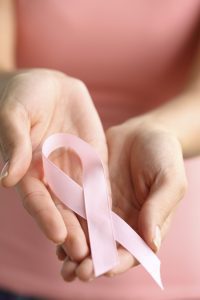A common breast cancer myth is that only women suffer from breast cancer. In actual fact, according to the latest American Cancer Society statistics, approximately 2190 men are diagnosed with breast cancer every year in the United States.
Recognizing Breast Cancer in Men
Male breast cancer most frequently appears as a hard lump near the nipple area (often just below). The nipple may pucker or turn inwards due to the lump and ulcers or discharge from the nipple are common symptoms. Swelling under one or both armpits can also be an indication.
Risk Factors for Breast Cancer in Men
Perhaps the greatest breast cancer risk factor for men is simply a lack of awareness. Thanks to the myth that only women get breast cancer and a stigma about accepting men have breast tissue, few men regularly examine themselves for lumps or take time becoming familiar with their “normal” breast anatomyThe study of the bodily structures and internal organs..
Men also suffer more commonly from a condition called Gynecomastia. The symptoms of gynecomastiaWhen a breast tissue in a man or boy becomes swollen. are easily confused with male breast cancer, particularly the appearance of breast lumps. This can lead to confusion and misdiagnosis.
Besides the risk of going undiagnosed, the most obvious risk factor for male breast cancer is increasing age, with men aged 60-70 most at risk. Like women, alcohol usage, obesity, high levels of estrogen and family history of breast cancer are also risk factorsAnything that increases or decreases a person’s chance of developing a disease. for men. A male-only illness called Klinefelter’s syndrome is another rare geneticInherited characteristics. factor which can put men more at risk of developing breast cancer.
An Early Detection Plan For Men
The Maurer Foundation’s 3-pronged early detection plan works for men, too:
- Breast Self Examination (BSE): Men theoretically have an easier job of detecting unusual lumps in their breasts as they have less tissue particularly around the nipple and areolaThe pigmented skin surrounding the nipple. than women. A successful breast self examination does require a degree of self-awareness, however.
- Clinical Breast Exam: Like BSE’s but performed by a trained specialist (doctor, nurse or other health care practitioner). Unlike women, who are recommended to have a clinical breast exam once a year beginning at age 20, most doctors do not regularly perform a clinical breast exam on their male patients. Men are encouraged to request that their doctors do so. In the event that a man feels a lump or notices any changes in his breast or nipple area, a clinical breast exam would be necessary.
- Breast Imaging: Since breast cancer incidenceIncidence refers to the occurrence of new cases of disease or injury in a population over a specified period of time. rates in males are low, men do not routinely undergo screening mammogramsA low dose x-ray picture of the breast that allows a doctor to view glandular tissue and determine the presence of cancer. for breast cancer. Men who are suspected of having breast cancer can benefit from the same range of breast imaging technology: from a breast x-ray (mammogram) to a scan using sound waves (ultrasound) or a magnetic field and radio wave scan (MRI). These different technologies allow either a 2D or 3D picture of the breast tissue to be built, making detection of potentially cancerous areas easier.
Why Does the Myth Exist?
Although men can develop breast cancer too, it is still relatively rare, and women are at a far greater risk. In fact, the American Cancer Society says, “Breast cancer is about 100 times less common among men than among women.” Why is this? Nobody is entirely sure, although a common theory is that simply by having more breast tissue, women have a greater mass in which to develop cancerous cells so are inevitably at higher risk. Women also tend to have much higher levels of estrogenA female sex hormone that is primarily produced by the ovaries. Its primary function is to regulate the menstrual cycle and assist in the production of secondary sex characteristics such as breasts. It may even play a role in the production of cancer cells in the breast tissue. which could well be a contributory factor.
Unfortunately, because breast cancer in men is not common, studies into it are also infrequent. Until this area of research develops further it is unlikely that we will get a more accurate answer to why men are less susceptible to breast cancer than women.
Post updated on May 14, 2020.
 A common
A common